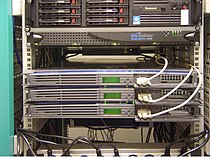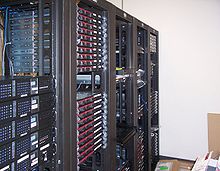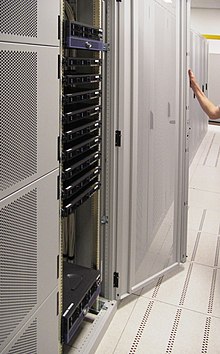Friday, 8 April 2011
Urdu Books: Aur Talwar Toot Gai by Naseem Hijazi (اور تلوار ٹوٹ گئی از محمد نسیم حجازی)
Posted by Muhammad Nasir on 11:16
Parts of computer
Posted by Muhammad Nasir on 11:08
The computer is a programmable finite state machine which can perform precise arithmetic and logic operations. A programmable finite state machine is one that can take on only one of a fixed range of values.
A list of instructions can be submitted to the computer in the form of a program. A task is performed by executing the corresponding program.
A collection of related programs are known as the Software.
The physical circuitry and components are known as Hardware.
Hardware can be categorized into five blocks; they are:
- Input Unit (I/P)
- Arithmetic and Logic Unit (ALU)
- Control Unit (CU)
- Memory
- Output Unit (O/P)
The input unit is the device used to enter data and instructions into the computer. The data read from the input device is stored in the computer’s memory. E.g. Keyboard, Joystick, Mouse, Light Pen .etc.

The Arithmetic and Logic Unit (ALU) performs arithmetic and logic operations. The arithmetic operations include addition, subtraction, multiplication and division. Logical operations include the Boolean functions such as AND, OR and NOT. These operations are used during conditional branching.
3. Control Unit (CU)
The Control Unit (CU) coordinates the activities of the various components of a computer. The Arithmetic and Logic Unit (ALU) and Control Unit (CU) together comprise the Central Processing Unit (CPU). The CPUs are called Microprocessors. The speed of a computer depends of the clock frequency of the microprocessors (Execution speed of instructions per seconds).

In addition to the main processor (CPU), there are coprocessors to speed up the operations of the main processor of a computer (basically the chip-set used in the motherboard of a computer is the coprocessor). They perform activities like floating point operations, memory management, and input-output management .etc.
4. Memory
The information (instruction and data) required is stored in memory. The Computer’s memory is constructed out of semi-conducting material and stores information in binary form. Binary information is composed of two symbols ‘0’ and ‘1’ called binary digits (bits). The memory is organized into equal sized unit (usually a collection of 8bits, called a byte). These units are arranged in a sequence and are defined by numbers called address (memory address). The memory of a computer can be divided into distinct parts as below.
Registers are locations within the microprocessor where data is stored temporarily during processing. These internal high speed registers are used in Arithmetic and Logic operations for holding data and operands. Some registers are accessible by the user through instructions. Others are reserved for the use of the CPU to perform its activities.
Cache is a small high speed memory that contains frequently used data. The use of cache avoids repeated reading of data from the slower main memory. Internal cache is located within the microprocessor (indicated as L1, L2 and L3 Cache).
External cache is used to supplement the internal cache. It is used when an internal cache is not available or not present. It is placed between the CPU and Main Memory (The size of the cache memory is indicated in the specification of the microprocessor). Cache size increases the performance of the microprocessor will also increases.
Main Memory stores the data and instructions required by the microprocessor. The main memory is also called RAM. Microprocessor instructions can directly access main memory locations. Main memory is fast but expensive. However, it is volatile; the contents stored will be lost when the power supply is cut off.
E.g.: SDRAM, DDR1 RAM, DDR2 RAM, DDR3 RAM (Main Memory types used in today’s Computer) .etc.

All the data and programs required by the computer cannot be stored in the main memory because it is small in size and volatile. Secondary memory is needed to store data and programs which is not currently required by the microprocessor. Secondary memory is slower but less expensive than the main memory. It is also non-volatile and larger in size. The processor can access the various type of memory in the memory hierarchy up to the main memory. The microprocessor cannot access the secondary memory directly. Therefore, data from the secondary memory has to be brought to the main memory so that the processor can use it. Memory management techniques are required to transfer information between the main memory and secondary memory, and this function is performed by the operating system.
E.g.: Hard Disk Drives, CD/DVD ROMs, Floppy Disk .etc.

Typical Modern Computer Memory Hierarchy Diagram

5. Output Unit (O/P)
Just as input devices are used to supply the computer with data, there should be some means for the computer to communicate with the user. The information generated by the computer is displayed using an output device.
E.g.: Printers, Monitors, Plotters .etc.

Typical Personal Computer with Peripherals (Input and Output Devices)

Typical Computer Storage Types

Top Android Resources
Posted by Muhammad Nasir on 11:03
As the Android market explodes, more online sites and android info apps appear. So the choice is wide!
Most will be aware that Android Market is de facto standard for downloading apps for your Android Phone. You can access the Android Market via your browser or Android Market App. The site gives you quick access to Featured, Top Free and Top Paid apps. It’s a pity they don’t tell you which Android platforms you need.
Other useful info Android Apps: AppAware : shares online your installations, updates and removals of Android applications. In this way you become aware (App-Aware) of what other users are installing on their mobile phones right now and/or around you! AndroidPit with its daily featured App and extensive review is a very useful app.
Where do you go for the latest Android Information? Online Android AllTop collates huge resource of Android information under a range of headings from Most Popular Stories, Goggle Mobile Blog to Android Social Media. You can access Access AllTop through the World Newspapers app. “Android Central” and “Android and Me” are also accessible via World Newspapers. Android Central lists the latest news with access to Articles, Reviews and Forums. Android and Me offers a similar feast of News, Phones, Carriers, Apps, Games, Calendar and Podcast.
Other News resources (RSS Feeds) – top up your Google Reader or alternative News Reader
Other Android App Feeds
Reference: http://www.androidupdate.org/
Thursday, 31 March 2011
Web hosting service
Posted by Muhammad Nasir on 09:07
A web hosting service is a type of Internet hosting service that allows individuals and organizations to make their own website accessible via the World Wide Web. Web hosts are companies that provide space on aserver they own or lease for use by their clients as well as providing Internet connectivity, typically in a data center. Web hosts can also provide data center space and connectivity to the Internet for servers they do not own to be located in their data center, called colocation or Housing as it is commonly called in Latin America or France.

The scope of hosting services varies widely. The most basic is web page and small-scale file hosting, where files can be uploaded via File Transfer Protocol (FTP) or a Web interface. The files are usually delivered to the Web "as is" or with little processing. Many Internet service providers (ISPs) offer this service free to their subscribers. People can also obtain Web page hosting from other, alternative service providers. Personal web site hosting is typically free, advertisement-sponsored, or inexpensive. Business web site hosting often has a higher expense.
Single page hosting is generally sufficient only for personal web pages. A complex site calls for a more comprehensive package that provides database support and application development platforms (e.g. PHP,Java, Ruby on Rails, ColdFusion, and ASP.NET). These facilities allow the customers to write or install scripts for applications like forums and content management. For e-commerce, SSL is also highly recommended.
The host may also provide an interface or control panel for managing the Web server and installing scripts as well as other services like e-mail. Some hosts specialize in certain software or services (e.g. e-commerce). They are commonly used by larger companies to outsource network infrastructure to a hosting company.
Types of hosting
A typical server "rack," commonly seen incolocation centres.
Internet hosting services can run Web servers; see Internet hosting services.
Many large companies who are not internet service providers also need a computer permanently connected to the web so they can send email, files, etc. to other sites. They may also use the computer as a website host so they can provide details of their goods and services to anyone interested. Additionally these people may decide to place online orders.
- Free web hosting service: offered by different companies with limited services, sometimes supported by advertisements, and often limited when compared to paid hosting.
- Shared web hosting service: one's website is placed on the same server as many other sites, ranging from a few to hundreds or thousands. Typically, all domains may share a common pool of server resources, such as RAM and the CPU. The features available with this type of service can be quite extensive. A shared website may be hosted with a reseller.
- Reseller web hosting: allows clients to become web hosts themselves. Resellers could function, for individual domains, under any combination of these listed types of hosting, depending on who they are affiliated with as a reseller. Resellers' accounts may vary tremendously in size: they may have their own virtual dedicated server to a collocated server. Many resellers provide a nearly identical service to their provider's shared hosting plan and provide the technical support themselves.
- Virtual Dedicated Server: also known as a Virtual Private Server (VPS), divides server resources into virtual servers, where resources can be allocated in a way that does not directly reflect the underlying hardware. VPS will often be allocated resources based on a one server to many VPSs relationship, however virtualisation may be done for a number of reasons, including the ability to move a VPS container between servers. The users may have root access to their own virtual space. Customers are sometimes responsible for patching and maintaining the server.
- Dedicated hosting service: the user gets his or her own Web server and gains full control over it (root access for Linux/administrator access for Windows); however, the user typically does not own the server. Another type of Dedicated hosting is Self-Managed or Unmanaged. This is usually the least expensive for Dedicated plans. The user has full administrative access to the box, which means the client is responsible for the security and maintenance of his own dedicated box.

- Managed hosting service: the user gets his or her own Web server but is not allowed full control over it (root access for Linux/administrator access for Windows); however, they are allowed to manage their data via FTP or other remote management tools. The user is disallowed full control so that the provider can guarantee quality of service by not allowing the user to modify the server or potentially create configuration problems. The user typically does not own the server. The server is leased to the client.
- Colocation web hosting service: similar to the dedicated web hosting service, but the user owns the colo server; the hosting company provides physical space that the server takes up and takes care of the server. This is the most powerful and expensive type of web hosting service. In most cases, the colocation provider may provide little to no support directly for their client's machine, providing only the electrical, Internet access, and storage facilities for the server. In most cases for colo, the client would have his own administrator visit the data center on site to do any hardware upgrades or changes.
- Cloud Hosting: is a new type of hosting platform that allows customers powerful, scalable and reliable hosting based on clustered load-balanced servers and utility billing. Removing single-point of failures and allowing customers to pay for only what they use versus what they could use.
- Clustered hosting: having multiple servers hosting the same content for better resource utilization. Clustered Servers are a perfect solution for high-availability dedicated hosting, or creating a scalable web hosting solution. A cluster may separate web serving from database hosting capability. (Usually Web hosts use Clustered Hosting for there Shared hosting plans, as there are multiple benefits to the mass managing of clients)
- Grid hosting: this form of distributed hosting is when a server cluster acts like a grid and is composed of multiple nodes.
- Home server: usually a single machine placed in a private residence can be used to host one or more web sites from a usually consumer-grade broadband connection. These can be purpose-built machines or more commonly old PCs. Some ISPs actively attempt to block home servers by disallowing incoming requests to TCP port 80 of the user's connection and by refusing to provide static IP addresses. A common way to attain a reliable DNS hostname is by creating an account with a dynamic DNS service. A dynamic DNS service will automatically change the IP address that a URL points to when the IP address changes.
Some specific types of hosting provided by web host service providers:
- File hosting service: hosts files, not web pages
- Image hosting service
- Video hosting service
- Blog hosting service
- One-click hosting
- Pastebin Hosts text snippets
- Shopping cart software
- E-mail hosting service
HTML5 Tutorials, Techniques and Examples for Web Developers
Posted by Muhammad Nasir on 08:49
HTML5 is a language for structuring and presenting content for the World Wide Web, a core technology of the Internet. It is the latest revision of the HTML standard (originally created in 1990) and currently remains under development. Its core aims have been to improve the language with support for the latest multimedia while keeping it easily readable by humans and consistently understood by computers and devices (web browsers, parsers etc.).
Following its immediate predecessors HTML 4.01 and XHTML 1.1, HTML5 is a response to the observation that the HTML and XHTML in common use on the World Wide Web is a mixture of features introduced by various specifications, along with those introduced by software products such as web browsers, those established by common practice, and the many syntax errors in existing web documents. It is also an attempt to define a single markup language that can be written in either HTML or XHTML syntax. It includes detailed processing models to encourage more interoperable implementations; it extends, improves and rationalises the markup available for documents, and introduces markup and APIs for complex web applications.[1]
In particular, HTML5 adds many new syntactical features. These include the
<video>,<audio>, and <canvas> elements, as well as the integration of SVG content. These features are designed to make it easy to include and handle multimedia and graphical content on the web without having to resort to proprietary plugins and APIs. Other new elements, such as<section>, <article>, <header>, and <nav>, are designed to enrich the semanticcontent of documents. New attributes have been introduced for the same purpose, while some elements and attributes have been removed. Some elements, such as <a>, <cite> and<menu> have been changed, redefined or standardised. The APIs and DOM are no longer afterthoughts, but are fundamental parts of the HTML5 specification.[1] HTML5 also defines in some detail the required processing for invalid documents, so that syntax errors will be treated uniformly by all conforming browsers and other user agents.[2]



